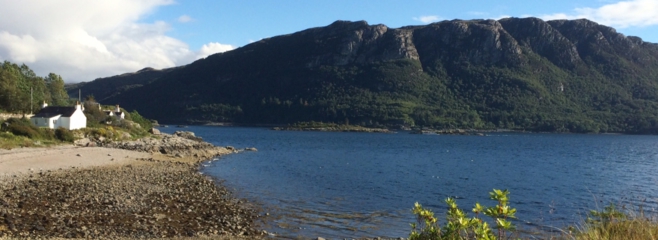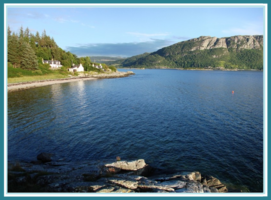
Some Cottage History
The Cottage 'Taobh na Dachaidh' was built around 1850s.
Evidence found during the renovation process suggests that the cottage was originally built as a 'Black House.' These traditional crofting cottages were generally built with double dry-stone walls packed with earth and wooden rafters covered with a thatch of turf with cereal straw or reed. The floor was generally flagstones or packed earth and there was a central hearth for the fire. There was no chimney for the smoke to escape through, instead the smoke made its way through the roof. Stones were often tied to a netting which was laid over the roof to help avoid wind damage (as seen in the image above). The blackhouse was used to accommodate livestock as well as people. People lived at one end and the animals lived at the other with a partition between them.
Taobh na Dachaidh (pronounced Tayv or Tiv na Dakkie and translates from Gaelic as Beside the Home - we think 'Home' in this context refers to a building, now lost, that would have been somewhere adjacent to the current property) was originally built on the rock with stone and a lime mortar. In the sitting room of Taobh na Dachaidh you will see a 'history window,' a framed and glazed hole in the wall surface. In this can be seen where timbers would have been that supported the original roof. Stones have been laid above the original wall height (using a coarse concrete instead of the lime mortar), leaving the holes where the timbers once rested. The ceiling was then raised to its current level and the walls were covered over using tongue and groove panelling. In the gable walls the original roof line can be seen as a rough diagonal line in the stones, further suggesting the later raising of the roof height. And to further add to the changing shape of the cottage, the sitting room window was once a door. The stone wall below the window is just a fill, the original sides to the doorway are still evident (behind the new wall-boarding!).
The Cottage has been owned by generations of the same family since it was built, meaning that there is a strong family history tied up in the property. In more recent years family and friends have used Taobh na Dachaidh as a holiday cottage. The current owners have now completed some renovations to help bring the accommodation up to modern standards.
Some images of the cottage before the renovation
Before the renovation the rooms were a quarter turn anti-clockwise. So the Kitchen was the sitting room, the Sitting Room was a bedroom, the Bedroom was the bathroom and the Bathroom was the kitchen (the wall between the old bathroom and kitchen was around a metre further up). Upstairs the layout has been unchanged. Much of the wood panelling from the old bedroom is now the new bedroom ceiling, the panelling over the fireplace in the old sitting room is now the window surround in the new bedroom and the fire place surround and mantle was made from the only two lengths of floor joist recovered from under the floor downstairs that were not rotten. All-in-all we have tried to recycle as much of the old cottage in the new-look cottage and have tried to maintain the essential feel of the traditional style that the cottage has had for decades.














